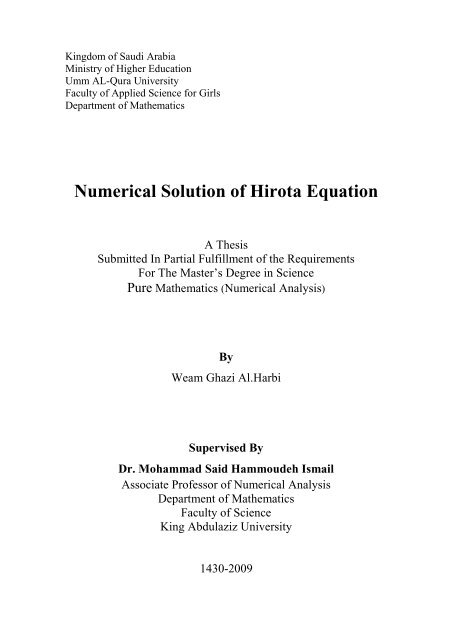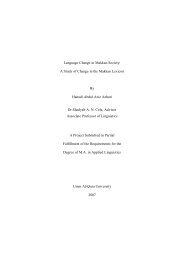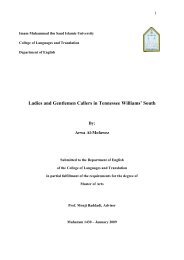Numerical Solution of Hirota Equation
Numerical Solution of Hirota Equation
Numerical Solution of Hirota Equation
Create successful ePaper yourself
Turn your PDF publications into a flip-book with our unique Google optimized e-Paper software.
Kingdom<br />
<br />
<strong>of</strong> Saudi Arabia<br />
Ministry <strong>of</strong> Higher Education<br />
Umm AL-Qura University<br />
Faculty <strong>of</strong> Applied Science for Girls<br />
Department <strong>of</strong> Mathematics<br />
<strong>Numerical</strong> <strong>Solution</strong> <strong>of</strong> <strong>Hirota</strong> <strong>Equation</strong><br />
A Thesis<br />
Submitted In Partial Fulfillment <strong>of</strong> the Requirements<br />
For The Master’s Degree in Science<br />
Pure Mathematics (<strong>Numerical</strong> Analysis)<br />
By<br />
Weam Ghazi Al.Harbi<br />
Supervised By<br />
Dr. Mohammad Said Hammoudeh Ismail<br />
Associate Pr<strong>of</strong>essor <strong>of</strong> <strong>Numerical</strong> Analysis<br />
Department <strong>of</strong> Mathematics<br />
Faculty <strong>of</strong> Science<br />
King Abdulaziz University<br />
1430-2009
المملكة العربية السعودية<br />
وزارة التعليم العالي<br />
أم القرى جامعة<br />
العلوم التطبيقية فرع الطالبات كلية<br />
الرايضيات<br />
قسم<br />
العليا ادلراسات<br />
"<br />
"<br />
<br />
אא <br />
<strong>Numerical</strong> <strong>Solution</strong> <strong>of</strong> <strong>Hirota</strong> <strong>Equation</strong><br />
<br />
<br />
{ } <br />
<br />
<br />
א<br />
<br />
א.<br />
أستاذ التحليل العددي المشارك بجامعة المكل عبد العزيز بجده<br />
كلية العلوم قسم الرايضيات<br />
٢٠٠٩/١٤٣٠
ABSTRACT<br />
<strong>Numerical</strong> <strong>Solution</strong> <strong>of</strong> <strong>Hirota</strong><br />
<strong>Equation</strong><br />
The aim <strong>of</strong> this thesis is to solve numerically the <strong>Hirota</strong> equation using<br />
finite difference method.<br />
This dissertation consists <strong>of</strong> three chapters and a list <strong>of</strong> references.<br />
In Chapter 1: we present in details, this equation and the exact<br />
solution, also we study its conserved quantities. The solution <strong>of</strong> the block<br />
penta-diagonal system and block septa-diagonal system are derived. We<br />
described the fixed point method and Newton’s method for solving the<br />
nonlinear system.<br />
In Chapter 2: we solve the <strong>Hirota</strong> equation numerically by using<br />
Crank-Nicolson method. The accuracy <strong>of</strong> the resulting scheme is second<br />
order in space and time and is unconditionally stable. Newton’s and fixed<br />
point methods are used for solving the nonlinear system. Also we use a<br />
linearized implicit technique.<br />
We give the some numerical examples to show that this method is<br />
conserving the conserved quantities. We give some experiments, like,<br />
single soliton and collision <strong>of</strong> two solitons.<br />
In Chapter 3: we use the same approach as we did in the previous<br />
chapter, but this time we are approximating the space derivatives in the<br />
<strong>Hirota</strong> equation by a fourth order replacement. The accuracy <strong>of</strong> the<br />
resulting scheme is fourth order in space and second order in time and is<br />
unconditionally stable. Newton’s and fixed point methods are used for<br />
solving the nonlinear system. Also we use a linearized implicit technique.<br />
We give the some numerical examples to show that this method is<br />
conserving quantities. We give some experiments like the one mentioned<br />
in chapter 2.<br />
- 1 -
א<br />
אא<br />
<br />
.<br />
<br />
: <br />
: <br />
<br />
. <br />
(Block Penta-diagonal System) <br />
.(Block Septa-diagonal System) <br />
. <br />
: <br />
<br />
. <br />
t,x <br />
<br />
<br />
. <br />
: <br />
<br />
x <br />
. <br />
t<br />
x <br />
<br />
. <br />
- 2 -
Introduction<br />
In this work, we aim to solve numerically the <strong>Hirota</strong> equation [11]<br />
∂ u<br />
+<br />
∂t<br />
3<br />
2 ∂u<br />
∂ u<br />
α u + γ = 0<br />
(1)<br />
∂x<br />
∂x<br />
3<br />
3<br />
where u is a complex valued function <strong>of</strong> the spatial coordinate x and the time t, α<br />
and γ are positive real constants. This equation is an integrable equation which has a<br />
number <strong>of</strong> physical applications, such as the propagation <strong>of</strong> optical pluses in nematic<br />
liquid crystal waveguides. The <strong>Hirota</strong> equation is closely related to both the nonlinear<br />
Schrodinger (NLS) and modified Korteweg-de Vries (mKdV) equations, as it is<br />
complex generalization <strong>of</strong> the mKdV equation and it is a part <strong>of</strong> the NLS hierarchy <strong>of</strong><br />
the integrable equation. Also, its soliton solution has a very similar form to the NLS<br />
soliton. The <strong>Hirota</strong> equation (1) has a two-parameter soliton family, with amplitude<br />
and velocity. The exact solution <strong>of</strong> Hitora equation (1) is<br />
u<br />
( x, t) β sec h[ κ( x − s − vt)<br />
] exp( iϕ)<br />
= , (2)<br />
2γ<br />
β = κ , φ = a ( x −bt − s ) , (3)<br />
α<br />
v a b a<br />
2 2 2 2<br />
= γ ( κ − 3 ) , = γ (3 κ − ) , (4)<br />
β is the amplitude <strong>of</strong> the wave, κ is related to the width <strong>of</strong> the wave envelope and<br />
v is the velocity. The parameter a is the wave number <strong>of</strong> the phase and b is related to<br />
the frequency <strong>of</strong> the phase. Also the solution is at x<br />
has the conserved quantities<br />
= s at t = 0 .The <strong>Hirota</strong> equation<br />
∞<br />
∞<br />
2<br />
⎛ α 4 2 ⎞<br />
1<br />
= ∫ = constant,<br />
2<br />
= ∫ ⎜ −<br />
x ⎟ = constant<br />
2<br />
−∞<br />
−∞ ⎝<br />
⎠<br />
(5)<br />
I u dx I u u dx<br />
The <strong>Hirota</strong> equation (1) has been solved analytically by sine-cosine and tanh methods<br />
by Wazwaz [33] and showed that this equation admits sech-shaped soliton solutions<br />
whose amplitudes and velocities are free parameters, and tanh solution (kink type).<br />
<strong>Hirota</strong> method can be used [9]. To avoid complex computation[13,14,15], we assume<br />
where u ( x t ),<br />
u ( x,<br />
t )<br />
coupled system<br />
( ) ( ) ( )<br />
2<br />
u x , t = u x , t + iu x , t , i = − 1<br />
(6)<br />
1 2<br />
1<br />
,<br />
2<br />
are real functions. This will reduce <strong>Hirota</strong> equation to the<br />
- 3 -
3<br />
∂u1 ∂u1 ∂ u1<br />
+ 3 αf ( u1 , u<br />
2 ) + γ = 0,<br />
3<br />
∂t ∂x ∂x<br />
3<br />
∂u 2<br />
∂u 2<br />
∂ u<br />
2<br />
+ 3 α f ( u1 , u<br />
2 ) + γ = 0,<br />
3<br />
∂t ∂x ∂x<br />
(7)<br />
where<br />
2 2<br />
( u , u ) = u .<br />
f +<br />
1 2 1<br />
u2<br />
The numerical solution <strong>of</strong> nonlinear wave equations has been the subject <strong>of</strong> many<br />
studies in recent years. Although many numerical schemes have been proposed for<br />
some well- known integrable equations, such as the Korteweg-de Vries (KdV)<br />
equation [5,25,29,30] and the nonlinear Schrodinger equation [28]. <strong>Numerical</strong><br />
solution <strong>of</strong> coupled differential is a fertile area, as an example, the coupled nonlinear<br />
Schrodinger equation admits soliton solution and it has many applications in<br />
communication and optical fibers, this system has been solved numerically by Ismail<br />
[13,14,15,17], the coupled Korteweg-de Vries equation [7,8,18,34]. The nonintegrable<br />
2<br />
variant <strong>of</strong> <strong>Hirota</strong> in which the nonlinear term in (1) is replaced by( u u ) , is solved<br />
numerically by [19,23].<br />
x<br />
This thesis consists <strong>of</strong> three chapters. In Chapter 1, we present in details, this<br />
equation and the exact solution, also we study its conserved quantities. The solution<br />
<strong>of</strong> the block penta-diagonal system and block septa-diagonal system are derived. We<br />
described the fixed point method and Newton's method for solving the nonlinear<br />
system. In Chapter 2, two numerical schemes are derived for solving Eq. (1), linear<br />
and nonlinear implicit schemes, both are <strong>of</strong> second order in both direction and they<br />
are unconditionally stable. The implicit nonlinear scheme produced a block nonlinear<br />
penta diagonal system solved by Newton's and fixed point methods. Also we use a<br />
linearized implicit technique for solving the linear penta diagonal scheme. numerical<br />
results for single soliton and the interaction <strong>of</strong> two solitons are given. In Chapter 3,<br />
two numerical schemes are derived for solving Eq. (1), linear and nonlinear implicit<br />
schemes, both are <strong>of</strong> fourth order in space and second order in time and they are<br />
unconditionally stable. The implicit nonlinear scheme produced block nonlinear septa<br />
diagonal system solved by Newton's and fixed point methods. Also we use a<br />
linearized implicit technique for solving the linear septa diagonal scheme. numerical<br />
results for single soliton and the interaction <strong>of</strong> two solitons are given.<br />
- 4 -
TABLE OF CONTENTS<br />
ABSTRACT ……………………………………………………………...………...<br />
ii<br />
ABSTRACT (Arabic) ………………………………………………………...…. iii<br />
DEDICATION ……………….. ……………………………………………………... iv<br />
ACKNOWLEDGEMENTS ……………………………………………………….... v<br />
LIST OF TABLES …………………………………………………………………… viii<br />
LIST OF FIGURES………………………………………………………………….. ix<br />
I THE HIROTA EQUATION ………………………………………………… 1<br />
1.1 Introduction ……………………………………………………………………... 1<br />
1.2 The <strong>Hirota</strong> <strong>Equation</strong> ………………………………….……………………….… 1<br />
1.3 Conserved Quantities …………………………………………………………… 2<br />
1.4 <strong>Solution</strong> <strong>of</strong> Block Penta-diagonal System………………………………………. 4<br />
1.5 <strong>Solution</strong> <strong>of</strong> Block Septa-diagonal System ……………………………………… 7<br />
1.6 Nonlinear System ……………………………………………………………….. 12<br />
1.6.1 Newton’s Method ………………………………………………………….. 13<br />
1.6.2 Fixed Point Method ………………………………………………………… 14<br />
II NUMERICAL SOLUTION OF HIROTA EQUATION (SECOND<br />
ORDER) ………………………………………………………....………………….. 17<br />
2.1 Introduction ………………………………………………………....................... 17<br />
2.2 <strong>Numerical</strong> Method …………………………………………………………….…. 17<br />
2.3 Iterative technique……………………………………………………………….... 20<br />
2.3.1 Newton.s Method …………………………………………………………... 20<br />
2.3.2 Fixed point method ………………………………………………………… 23<br />
2.3.3 Accuracy <strong>of</strong> the scheme ……………………………………………………. 26<br />
2.3.4 Stability <strong>of</strong> the Scheme .……………………………………………………. 28<br />
2.4 linearly implicit method .…………………………………………………………. 30<br />
2.4.1 Accuracy <strong>of</strong> the scheme ……………………………………………………. 34<br />
2.4.2 Stability <strong>of</strong> the Scheme …………………………………………………….. 35<br />
2.5 <strong>Numerical</strong> Results ………………………………………………………………... 37<br />
- 5 -
2.5.1 Single soliton ………………………………………………………………. 37<br />
2.5.2 Collision <strong>of</strong> Two solitons …………………………………………………... 45<br />
III NUMERICAL SOLUTION OF HIROTA EQUATION (FOURTH<br />
ORDER) ……………………………………………………………………………... 55<br />
3.1 Introduction ………………………………………………………………………. 55<br />
3.2 <strong>Numerical</strong> Method ………………………………………………………………...55<br />
3.3 Iterative technique …………………………………………………………………58<br />
3.3.1 Newton’s Method …………………………………………………………... 58<br />
3.3.2 Fixed point method ………………………………………………………… 61<br />
3.3.3 Accuracy <strong>of</strong> the scheme ……………………………………………………. 65<br />
3.3.4 Stability <strong>of</strong> the Scheme …………………………………………………….. 67<br />
3.4 linearly implicit method ………………………………………………………….. 70<br />
3.4.1 Accuracy <strong>of</strong> the scheme ……………………………………………………. 75<br />
3.4.2 Stability <strong>of</strong> the Scheme …………………………………………………….. 77<br />
3.5 <strong>Numerical</strong> Results ………………………………………………………………... 79<br />
3.5.1 Single soliton ………………………………………………………………. 79<br />
3.5.2 Collision <strong>of</strong> Two solitons …………………………………………………... 86<br />
Conclusion………………………………………………………………….……….. 96<br />
References…………………………………………………………………………… 97<br />
Arabic Summary<br />
- 6 -



![[1] C.D . Green, Integral Equations Methods, Thomas Nelson ...](https://img.yumpu.com/51398122/1/184x260/1-cd-green-integral-equations-methods-thomas-nelson-.jpg?quality=85)












